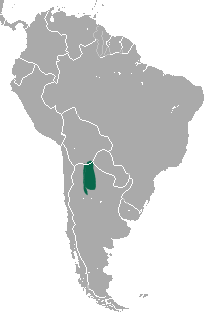
Opossums are members of the marsupial order Didelphimorphia endemic to the Americas. The largest order of marsupials in the Western Hemisphere, it comprises 126 species in 18 genera. Opossums originated in South America and entered North America in the Great American Interchange following the connection of North and South America.
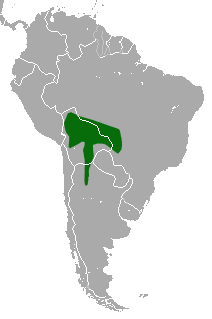
The white-bellied woolly mouse opossum is a small pouchless marsupial of the family Didelphidae. It was formerly assigned to the genus Micoureus, which was made a subgenus of Marmosa in 2009. The specific epithet was given in honour of Constance Sladen, wife of the naturalist Percy Sladen. She funded the 1902 expedition which collected the type specimen.
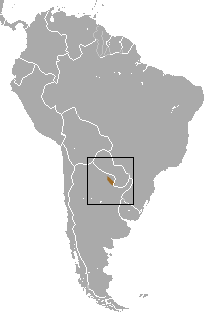
The Chacoan pygmy opossum is a recently described genus and species of didelphimorph marsupial. The only species in Chacodelphys, C. formosa, was known until 2004 from only one specimen collected in 1920 in the Chaco of Formosa Province, Argentina. The species is gaining popularity as a pocket pet.

The gray four-eyed opossum is an opossum species from Central and South America, ranging from southern Mexico to Peru, Bolivia and southwestern Brazil, at altitudes from sea level to 1600 m, but generally below 1,000 metres (3,300 ft). Its habitats include primary, secondary and disturbed forest. It is one of many opossum species in the order Didelphimorphia and the family Didelphidae.
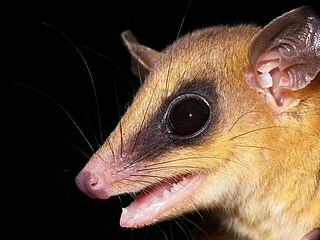
The 27 species in the genus Marmosa are relatively small Neotropical members of the family Didelphidae. This genus is one of three that are known as mouse opossums. The others are Thylamys and Tlacuatzin, the grayish mouse opossum. Members of the genus Marmosops used to be called "slender mouse opossums", but are now just called "slender opossums". The thirteen members of the Marmosa subgenus Micoureus, known as woolly mouse opossums, were formerly considered to be a separate genus, but were moved into Marmosa in 2009. Based on a comparison of sequences of one mitochondrial and three nuclear genes, three new subgenera, Eomarmosa, Exulomarmosa and Stegomarmosa, were recognized by Voss et al. in 2014. Eomarmosa and Exulomarmosa, as well as Marmosa and Micoureus, are thought to be sister taxa, while Stegomarmosa is viewed as sister to Marmosa plus Micoureus. Exulomarmosa is a mostly trans-Andean clade.
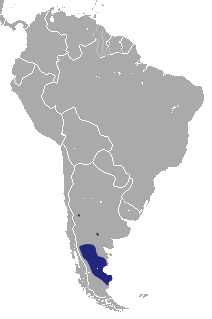
The Patagonian opossum(Lestodelphys halli) is the sole species in genus Lestodelphys.

The Brazilian gracile opossum is a species of small opossum from Brazil.

The yellow-sided opossum is an opossum species from South America. It is found in Argentina, Brazil and Uruguay. They have grey or black fur on their dorsal side with yellowish fur on the lateral side that continues down to the feet. They are the most mysterious of all the Monodelphis that is found specifically in the Pampean region or Pampa of Argentina. It is suspected to be a once-in-a-lifetime breeder as seen in a three-year observational study of one population in the marshy grasslands of the Pampean region. Maintaining their native grasslands is important for them to keep a stable population. They show sexual dimorphism in overall size: adult males are typically 100-150 g whereas adult females are 30-70 g.

The dwarf fat-tailed mouse opossum, also known as the velvety fat-tailed opossum is an opossum species from South America. It is endemic to Brazil, where it is found in cerrado and caatinga habitats. Its head-and-body length is about 141-212 mm, and its tail length is about 73-85 mm. Its diet is 44% arthropods; 75% of its diet consists of animals and animal products. Its ventral fur is entirely gray-based. Its hind foot is less than 14 mm, which is short for the genus.
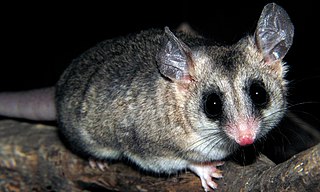
The elegant fat-tailed mouse opossum, also known as the Chilean mouse opossum, is an opossum from central Chile. The type species of Thylamys, it was first described by English naturalist George Robert Waterhouse in 1839. This medium-sized opossum is characterized by black rings around the eyes, white limbs, gray to light brown coat, lighter flanks and underbelly and a thick 12.7–14.6 centimetres (5.0–5.7 in) long tail covered with hairs. It is crepuscular and lives in nests in tree hollows or under rocks and roots. This opossum feeds mainly on arthropods and larvae apart from fruits. Litter size is typically between 11 and 13. The elegant fat-tailed opossum can occur in a variety of habitats – from cloud forests to chaparrals. The IUCN classifies the opossum as least concern.

Thylamys is a genus of opossums in the family Didelphidae. The premaxillae are rounded rather than pointed. The females lack a pouch. The females' nipples are arranged in two symmetrical rows on the abdomen. All species but T. macrurus store fat in their tails., although this is not necessarily true for all species in the genus. Fossils belonging to the genus date back to the Miocene, with the oldest specimens being found in the Cerro Azul Formation of Argentina and the Honda Group of Colombia. Genetic studies indicate that the genus may have originated around 14 million years ago.

The Paraguayan fat-tailed mouse opossum is a species of opossum in the family Didelphidae. It is found in forested areas of Brazil and Paraguay. It is known only from a few specimens. For two listed specimens, one had a head-and-body length of about 135 mm and a tail length of about 140 mm, while the other had a head-and-body length of about 120 mm and a tail length of about 155 mm. Most of its fur is gray, but the shoulder areas are reddish gray, and the ventral fur is pure white or creamy white. There is also a ring of black fur surrounding each eye. The ventral surface of the tail is white. The dorsal surface of the tail is gray for the first one third to one half of its length ; the remainder of the dorsal surface of the tail is white. The tail is hairless except for about its first ten mm. Although the genus Thylamys is characterized by fat storage in the tail, there is no evidence that this species stores fat in its tail.

The white-bellied fat-tailed mouse opossum is a species of opossum in the family Didelphidae. It is found in Argentina, Bolivia, Chile and Peru.
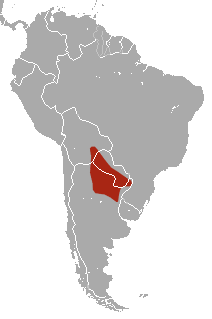
The common fat-tailed mouse opossum is a species of opossum in the family Didelphidae. It occurs in Argentina, Bolivia, and Paraguay in chaco and Andean foothill habitats. Its head-and-body length is about 75 to 120 mm, and its tail length is about 90 to 134 mm. Its dorsal fur is brownish gray, and its ventral fur is yellowish to white. The legs and cheeks are the same color as the ventral surface. Its tail is sharply bicolored. A ring of faintly darker fur surrounds each eye. Its tail often lacks fat deposits, but does not always.
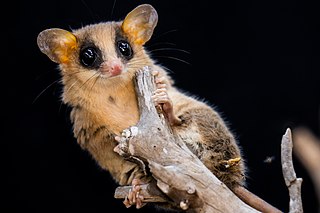
Gracilinanus is a genus of opossum in the family Didelphidae. It was separated from the genus Marmosa in 1989, and has since had the genera Cryptonanus, Chacodelphys, and Hyladelphys removed from it.

The Cinderella fat-tailed mouse opossum is a species of opossum in the family Didelphidae. It is found in northern Argentina and southern Bolivia, in the eastern foothills of the Andes. Its dorsal fur is gray brown to dark brown. Its ventral fur is gray-based, except for the white to yellowish chest hairs. It has been distinguished from T. sponsorius by the well-developed postorbital ridges of the latter, but mitochondrial DNA sequence analysis does not support separate species status for sponsorius.

Karimi's fat-tailed mouse opossum is a species of opossum in the family Didelphidae. It is endemic to central and northeast Brazil, where it is found in the cerrado and caatinga at elevations from 300 to 1100 m. This opossum is crepuscular and mostly terrestrial; its omnivorous diet includes leaves, insects and small vertebrates. Its head-and-body length is about 95 millimeters, and its tail length is about 72 millimeters. It is very similar to T. pallidor. Its tail may be nonprehensile. The species is named after Iranian epidemiologist Y. Karimi. It is threatened by habitat destruction and fragmentation due to agriculture and ranching.
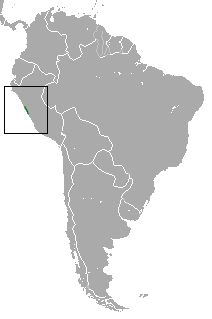
Tate's fat-tailed mouse opossum is a species of opossum in the family Didelphidae, named after American zoologist George Henry Hamilton Tate. It is found at elevations of 300 to 3,000 m along the coast of central Peru. The species has the northernmost range of any member of its genus. It has white ventral fur and short condylobasal and zygomatic lengths. T. pallidior is very similar.

The buff-bellied fat-tailed mouse opossum is a species of opossum in the family Didelphidae. It is found in the transitional and humid forests of northern Argentina and southern Bolivia. Its dorsal fur is cinnamon brown. Most of its ventral fur is gray-based, but its chest, throat, and the thoracic midline are not gray-based. The postorbital ridges are absent in the young and weakly developed in adults.
